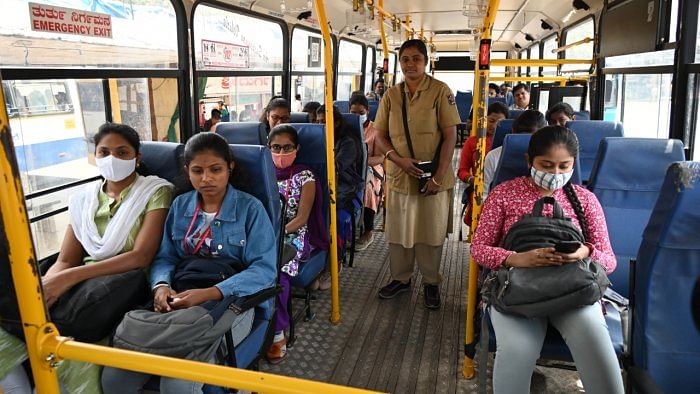
As temperatures cool down and the monsoon sets in, on the governance front it is raining schemes. The Karnataka government, as part of its five promises programme has announced free bus travel to all women in the state. Expectedly, this announcement has received reactions ranging from criticism that it encourages ‘freebie culture’ to being hailed as ‘revolutionary’. The truth lies somewhere in between.
Free bus travel is a welcome step, and will move the needle on women’s mobility. But for this to have a meaningful impact in the long term, the government needs to bring back the focus on economic growth with employment opportunities for women.
Basics of economic reasoning tells us that a bus ride is a private good — that is, it is rivalrous and excludable, and, therefore, the market will take care of the mobility needs of people at different price points. The case for the government providing bus services stems from the fact that the market is not incentivised to service all routes demand due to low profitability. The BMTC, thus, addresses this failure, but also suffers from revenue pressures. In this situation, it is tempting to label the move as an imprudent one. But is it so?
While the market is one pillar of democracy, the other two pillars — the government and society also influence and are influenced by public policy. Additionally, there are several issues that lie at the intersection of government and society — gender- and caste-related issues being chief among them.
To what extent can the government intervene in these cases? Among the broad spectrum of actions at its disposal, the government can choose to ‘nudge’ or to ‘change incentives’, if it wants to minimise the extent of intervention, and save bandwidth in enforcing the move. The free bus rides to women have elements of both these actions, and make it desirable for a variety of reasons.
One of the challenges plaguing the economy is low female labour force participation. The solution to this lies at the intersection of markets and society. Issues of safety, societal norms around education, and employment of women are some reasons holding back the participation of women in the labour markets.
Can free bus travel nudge people to change their attitudes? Free transport will bring more women on to public transport. This strength in numbers will make them feel safer and could break down barriers to employment. This can materially change conditions in the labour market, leading to the welfare for all. Similarly, if we can get enrolment rates to increase by reducing the cost of travel, it could go a long way in expanding educational choices for women, thereby impacting social outcomes.
Women are tasked with care work such as picking up children, shopping, etc., the many hop-on hop-off trips make commuting more expensive for women. To the extent that it would reduce their financial burden while society catches up with more egalitarian norms, this move is welcome.
While the issue of women in workplaces is much talked about, the issue of women and leisure does not get discussed enough. The presence of women in public spaces — roads, parks, city squares, among others, are an important indicator of a society’s attitudes towards women, and this is dismal in India. On the margin, reducing costs of leisure for women from lower income households through free bus rides may help women claim public spaces, which they have equal rights over.
The way forward
Free bus travel is not a silver bullet. There will be several challenges in the implementation of this scheme. The increase in demand will necessitate expansion of capacity through fleet strength, and human resources, further draining the State exchequer. The government will need to find other sources to offset some of this loss to make it viable in the long run. This is just one of the levers that the government can use to alter economic and societal outcomes. For the long term, the government should provide enough reasons for people to be using public transport, viz. economic activity.
This move only places more onus on the government to ensure it carries out its basic functions effectively, which is to create a conducive environment for businesses and employment and guarantee public safety for everyone.
For now, let's hope women make the most of this initiative.
Suman Joshi is Program Manager, The Takshashila Institution.
Disclaimer: The views expressed above are the author's own. They do not necessarily reflect the views of DH.